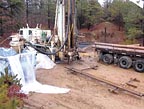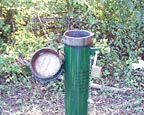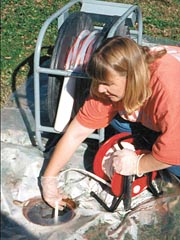
1) construct the well with minimum disturbance to the formation;
2) construct the well of materials that are compatible with the anticipated geochemical and chemical environment;
3) properly complete the well in the desired zone;
4) adequately seal the well with materials that will not interfere with the collection of representative water samples; and
5) sufficiently develop the well to remove any additives associated with drilling and provide unobstructed flow through the well.
In addition to appropriate construction details, the monitoring well must be designed in concert with the overall goals of the monitoring program. Key factors that must be considered include:
- intended purpose of the well;
- placement of the well to achieve accurate water levels and/or representative water-quality samples;
- adequate well diameter to accommodate appropriate tools for well development, aquifer testing equipment and water-quality sampling devices; and
- surface protection to assure no alteration of the structure or impairment of the data collected from the well.
If proper monitoring well design and construction techniques are not employed during monitoring well installation, the data collected from the well may not be reliable. For example, it has been determined that the solvent used to weld lengths of PVC casing together can leach significant amounts of tetrahydrofuran, methylethyl ketone, methylbutyl ketone and other synthetic organic chemicals into water that comes in contact with the solvent-welded casing joint. This could result in false determinations of the presence of certain chemical constituents in water samples taken from PVC wells in which the joints were solvent welded.
Monitoring well installation procedures also can have a significant impact on the integrity of ground water samples. Organic drilling fluids and bentonite drilling muds used in mud rotary drilling can have an effect on the chemical oxygen demand of ground water adjacent to the wellbore in a rotary-drilled well. This, in turn, can affect the quality of a water sample taken from such a well, resulting in the acquisition of non-representative ground water samples.
Vertical seepage of leachate along well casing also can produce non-representative samples. Monitoring wells frequently are sealed with neat cement grout, bentonite or a cement-bentonite mixture. The correct choice of a grout and the proper emplacement method to ensure a seal are critical to assure ground water sample integrity and prevent cross contamination of aquifers. While a neat cement grout often is recommended, shrinkage and cracking of the cement upon curing can create an improper seal. The smooth surface of thermoplastic casing provides a potential path for vertical leakage between the casing and the grout material. The implications of the impact of adhesion, including chemical bonding, versus swell pressure have not been documented. However, it is known that vertical leakage between the casing and the grout material may occur because of swelling and shrinkage during the curing of the grout.
Monitoring Well Performance
The purpose of maintaining a monitoring well is to extend the life of the well and to provide representative levels and samples of the ground water surrounding the well. Maintenance includes proper documentation of factors that can be used as benchmarks for comparison of data at a later point. A scheduled maintenance program should be developed before sample quality is questioned.
Documenting Performance
A monitoring well network should be periodically evaluated to determine that the wells are functioning properly. Once complete construction and as-built information is on file for each well, the well should be periodically re-evaluated to check for potential problems. The following checks can be used as a “first alert” for potential problems:1) The depth of the well should be recorded every time a water sample is collected or a water-level reading taken. These depths should be reviewed at least annually to document whether or not the well is filling with sediment;
2) If turbid samples are collected from a well, redevelopment of the existing well should be considered or a new well should be installed if necessary;
3) Hydraulic conductivity tests should be performed every five years or when significant sediment has accumulated;
4) Slug or pump tests should be performed every five years. Redevelopment is necessary if the tests show that the performance of the well is deteriorating;
5) Piezometric surface maps should be plotted and reviewed at least annually; and
6) High and low water-level data for each well should be examined at least every two years to assure that well locations (horizontally and vertically) remain acceptable. If the water level falls below the top of the well intake, the quality of the water samples collected can be altered.
Where serious problems are indicated with a well, geophysical logs may be helpful in diagnosing maintenance needs. Caliper logs provide information on diameter that may be used to evaluate physical changes in the borehole or casing. Gamma logs can be used to evaluate lithologic changes and can be applied to ascertain whether or not well intakes are properly placed. Spontaneous potential logs can locate zones of low permeability where siltation may originate. Resistivity logs identify permeable and/or porous zones to identify formation boundaries. Television and photographic surveys can pinpoint casing problems and well intake failure and/or blockage. When used in combination, geophysical logs may save time and money in identifying problem areas.
Contributing Factors
The maintenance requirements of a well are influenced by the design of the weIl and the characteristics of the monitored zones. Water quality, transmissivity, permeability, storage capacity, boundary conditions, stratification, sorting and fracturing all can influence the need for and method(s) of well maintenance. Problems with monitoring wells typically are caused by poor well design, improper installation, incomplete development, borehole instability and chemical, physical and/or biological incrustation.Design - A well is improperly designed if hydrogeologic conditions, water quality or well intake design are not compatible with the purpose and use of the monitoring well. For example, if water is withdrawn during the sampling process and the well screen is plugged, the hydrostatic pressure on the outside of the casing may be great enough to cause collapse of the well intake if the strength of the material was not sufficient for the application. This is particularly true if the well intake material was chemically incompatible with the ground water and was weakened due to chemical reactions. Another example is where the operational life of the monitoring well exceeds the design life. If a well was installed for short-term water level measurements and the well ultimately is used for long-term sample collection, problems with material comparability may occur. Additionally, if the well intake openings are improperly sized and/or if the filter pack is incorrectly designed or installed, siltation and turbid water samples can result.
Installation - If productive zones are not accurately identified during the well drilling process, well intakes can be improperly located or zones can be improperly sealed. Incorrect installation procedures and/or difficulties may also cause dislocation of well intakes and/or seals. Improperly connected or corroded casing can separate at joints or collapse and cause interaquifer contamination. Improperly mixed grout can form inadequate seals. If casing centralizers are not used, grout distribution may be inadequate. If the casing is corroded or the bentonite seal not properly placed, grout may contaminate the water samples. Drilling mud filtrate may not have been completely removed during the development process. The surface seal could have been deteriorated or could have been constructed improperly, and surface water may infiltrate along the casing/borehole annulus. The intake filter pack must be properly installed.
Development - Drilling mud, natural fines or chemicals used during drilling must be removed during the development process. If these constituents are not removed, water-sample quality may be compromised. Chemicals also can cause screen corrosion, shale hydration or plugging of the well intake. In general, the use of chemicals is not recommended, and any water added during the development process must be thoroughly tested.
Borehole stability - Unstable boreholes contribute to casing failure, grout failure or screen failure. Borehole instability can be caused by factors such as improper well intake placement, excessive entrance velocity or shale hydration.
Incrustation - There are four types of incrustation that reduce well production - chemical, physical, biological or a combination of the three. Chemical incrustation may be caused by carbonates, oxides, hydroxides or sulfate depositions on or within the intake. Physical plugging of the wells is caused by sediments plugging the intake and surrounding formation. Biological incrustation is caused by bacteria growing in the formation adjacent to the well intake or within the well. The bacterial growth rate depends on the quantities of nutrients available. The velocity at which the nutrients travel partially controls nutrient availability. Some biological contamination may originate from the ground surface and be introduced into the borehole during drilling. Nutrients for the organisms also may be provided by some drilling fluids, additives or detergents.

Downhole Maintenance
Many wells accumulate sediment at the bottom. Sand and silt may penetrate the screen if the well is improperly developed or screen openings improperly sized. Rocks, insects or waterlogged twigs also can enter the well through casing from the surface. Sediment also can be formed by precipitates caused by constituents within the water reacting with oxygen at the water surface.If sediment build-up occurs, the sediment should be removed. A sediment layer at the bottom of the well encourages bacterial activity that can influence sample quality. In wells that are less than 25 feet deep, sediment can be removed by a centrifugal pump, and an intake hose can be used to vacuum the bottom of a well. In wells deeper than 25 feet, a hose with a foot valve can be used as a vacuum device to remove sediment. In some situations, bailers also can be used to remove sediment. Sediment should be removed before purging and sampling to eliminate sample turbidity and associated questions about sample validity.
More traditional maintenance/rehabilitation techniques used to restore yields of water supply wells include chemical and mechanical methods that often are combined for optimum effectiveness. Three categories of chemicals are used in traditional well rehabilitation - acids, biocides and surfactant. The main objectives of chemical treatment are to dissolve the incrustants deposited on the well intake or in the surrounding formation, to kill the bacteria in the well or surrounding formation and to disperse clay and fine materials to allow removal. Chemicals have very limited application in the rehabilitation of monitoring wells because the chemicals cause severe changes in the environment of the wells. These changes may last for a long time or may be permanent. Before redevelopment with chemicals is considered, the negative aspects of chemical alteration in an existing well with a long period of record must be evaluated against negative aspects of replacing the old well with a new well that may have new problems and no history. If chemical rehabilitation is attempted, parameters such as Eh, pH, temperature and conductivity should be measured. These measurements can serve as values for comparison of water quality before and after well maintenance.
Mechanical rehabilitation includes overpumping, surging, jetting and air development. Development with air is not recommended because the introduction of air can change the chemical environment in the well. Any type of rehabilitation for incrustation can be supplemented by use of a wire brush or mechanical scraper with bailing or pumping to remove the loose particles from the well.
Exterior Well Maintenance
Maintenance also must be performed on the exposed parts of the well. Any well casing, well cap, protective casing, sampling tubing, bumper guard and/or surface seal should periodically be inspected to ensure that monitoring well sample quality will not be adversely affected. Suggested routine inspection and maintenance options:1) Exposed well casing should be inspected. Well casing should be of good structural integrity and free of any cracks or corrosion;
2) The well cap should be removed to inspect for spider webs, molds, fungi or other evidence of problems that may affect the representativeness of water samples. If no organisms and/or associated evidence are found, the upper portion of the casing should be cleaned with a long-handled brush or other similar tool. The cleaning should be scheduled after sample collection, and the well should be completely purged after cleaning;
3) When metal casing is used as protective casing and a threaded cap is used, the casing should be inspected for corrosion along the threads. Corrosion can be reduced by lightly lubricating or applying Teflon tape to the threads to prevent seizing. Corrosion of the casing can be reduced by painting. If lubricants and/or paint are used, the lubricants and/or paint should be prevented from entering the well;
4) Where multilevel sampling tubes are used, the tubes should rechecked for blockages and labeling so that samples are collected from the intended zones;
5) Where exterior bumper guards are used, the bumper guards should be inspected for mechanical soundness and periodically painted to retain visibility; and
6) Surface seals should be inspected for settling and cracking. When settling occurs, surface water can collect around the casing. If cracking occurs or if there is an improper seal, the water may migrate into the well. Well seal integrity can best be evaluated after a heavy rain or by adding water around the outside of the casing. If the seal is damaged, the seal should be replaced.
Comparative Costs
Evaluating the cost of rehabilitating a well versus abandoning and re-drilling the well is an important consideration. Factors that should be evaluated are the construction quality of the well, the accuracy of the well-intake placement and the precision of the documentation of the well. Capital costs of a new well should also be considered. The actual cost of rehabilitation is hard to calculate. Different rehabilitation programs may be similar in technique and price but may produce very different results. In some situations, different treatment techniques may be necessary to effectively treat adjacent wells. Sometimes techniques that once improved a well may only have a short-term benefit or may no longer be effective. However, the cost of not maintaining or rehabilitating a monitoring well maybe very high. The money spent through the years for sample collection and laboratory sample analyses may be wasted by the collection of unrepresentative data. Proper maintenance and rehabilitation in the long run is a good investment. If rehabilitation is not successful, abandonment of the well should be considered.ND
Report Abusive Comment